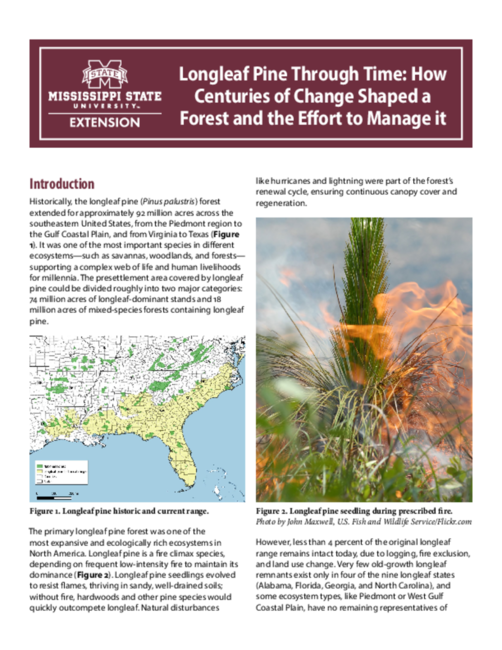P4134
Longleaf Pine Through Time: How Centuries of Change Shaped a Forest and the Effort to Manage it
Download the complete publication by selecting the publication image in the right column.
Historically, the longleaf pine (Pinus palustris) forest extended for approximately 92 million acres across the southeastern United States, from the Piedmont region to the Gulf Coastal Plain, and from Virginia to Texas. It was one of the most important species in different ecosystems—such as savannas, woodlands, and forests—supporting a complex web of life and human livelihoods for millennia. The presettlement area covered by longleaf pine could be divided roughly into two major categories: 74 million acres of longleaf-dominant stands and 18 million acres of mixed-species forests containing longleaf pine.
The primary longleaf pine forest was one of the most expansive and ecologically rich ecosystems in North America. Longleaf pine is a fire climax species, depending on frequent low-intensity fire to maintain its dominance. Longleaf pine seedlings evolved to resist flames, thriving in sandy, well-drained soils; without fire, hardwoods and other pine species would quickly outcompete longleaf. Natural disturbances like hurricanes and lightning were part of the forest’s renewal cycle, ensuring continuous canopy cover and regeneration.
However, less than 4 percent of the original longleaf range remains intact today, due to logging, fire exclusion, and land use change. Very few old-growth longleaf remnants exist only in four of the nine longleaf states (Alabama, Florida, Georgia, and North Carolina), and some ecosystem types, like Piedmont or West Gulf Coastal Plain, have no remaining representatives of the primary forest. Fortunately, a growing interest in restoring longleaf for wildlife habitat, climate resilience, and cultural heritage is sparking renewed efforts across public and private lands.
This publication aims to track the origins and decline of the longleaf pine ecosystem from a historical and social point of view. By understanding the ecological, cultural, and industrial factors that shaped this landscape, landowners, natural resource professionals, and longleaf pine enthusiasts can make more informed decisions about restoring and sustaining longleaf pine habitats today.
For answers to specific questions, please contact state Extension specialists or your local Extension office.
Publication 4134 (POD-10-25)
By Andrea De Stefano, PhD, Assistant Professor, Coastal Research and Extension Center.
The Mississippi State University Extension Service is working to ensure all web content is accessible to all users. If you need assistance accessing any of our content, please email the webteam or call 662-325-2262.
